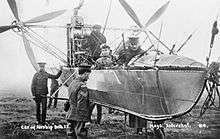Neville Usborne
| Neville Florian Usborne | |
|---|---|
| Born |
27 February 1883 Queenstown, Ireland |
| Died |
21 February 1916, aged 32 Strood |
| Buried at | Woodlands cemetery, Gillingham, Kent |
| Allegiance | United Kingdom |
| Service/branch |
Royal Navy Royal Naval Air Service |
| Years of service | 1897-1916 |
| Rank | Wing Commander |
Neville Usborne (27 February 1888 – 21 February 1916) was a British naval officer who played a prominent part in British military lighter-than-air aviation before the First World War. He was involved with the construction of the first British rigid airship HMA No. 1 and was killed in one of the first experiments in launching an aeroplane from an airship.
Biography
Usborne was born on 27 February 1883 in Queenstown, Ireland, the third son of George Usborne, a former naval officer who was deputy harbourmaster at Cork, and his wife Edith Josephine.
Early career
In 1897 he became a cadet in the Royal Navy, entering the training ship HMS Britannia. In 1898, now a midshipman, he achieved the second-highest marks in his year and was also awarded a prize for French.[1] In December 1899 he was posted to HMS Canopus[2] and in 1903 he was promoted to sub-lieutenant, and entered the newly formed submarine service, joining HMS Latona[3] In January 1904 he was promoted to full lieutenant, with seniority back-dated to March 1903.[4] and shortly afterwards posted to HMS Doris[5] In March 1905 he was posted to the torpedo school at HMS Vernon.[6]
Aviation career

In 1909 he was sent to Barrow-in-Furness to supervise the construction of the Navy's first rigid airship, H.M.A. No. 1 being built by Vickers,[7] and was posted to HMS Hermione, a cruiser acting as the tender for the airship, in September 1910. He is credited with making significant contributions to the design of the airship,[8] and the Inspecting Captain of Airships Murray Sueter later appointed him to be the captain of the airship when it was completed.[9] Unfortunately the airship subsequently broke its back without having made a successful flight, and development was abandoned. Usborne remained attached to Hermione until January 1912. In April 1912 he was promoted to Squadron Commander in the RNAS.[10]
His interest in flying was not confined to lighter-than air flight, and he took flying lessons at the Ewen School at Hendon, and was awarded Aero Club Certificate No. 449 on 1 April 1913.[11] In October 1913 he was given command of H.M.A.3, an Astra-Torres airship, in which capacity he once had Winston Churchill, then First Lord of the Admiralty, as a passenger.[12]

He was promoted to Commander on January 1, 1914, and in April 1914 was appointed the commanding officer of RNAS Kingsnorth. On 1 July 1914 Neville was promoted to Wing-Commander, and on 13 August 1915 he was appointed Inspector Commander of Airships at the Admiralty.
As a defence against the German Zeppelin bombing raids Usborne and Squadron Commander de Courcy Ireland (of RNAS Great Yarmouth) had developed a method of suspending a B.E.2c from an airship: this would be able to reach altitude quickly and patrol as an airship, the aeroplane being detached once a Zeppelin had been found. Some preliminary trials were made in August 1915, but on the first full trial attempt on 21 February 1916 Usborne and Ireland had taken off from RNAS Kingsnorth and reached an altitude of about 4,000 ft (1200 m) when a loss of pressure in the airship caused it to buckle, in turn causing the forward suspension cable to part. Overloaded, the rear cables failed: the aircraft went into a sideslip and then turned over, throwing out Ireland:[13] Neville remained with the aircraft, which crashed in Strood station goods yard.[14][15]
Private life
He married Betty Hamilton, the daughter of Mr. and Mrs. Vereker Monteith Hamilton at St Margaret's, Westminster on 23 February 1914.
Legacy
The Usborne Memorial Prize for best contribution to the Royal Aeronautical Society's publications written by a graduate or student was established in his memory.
References
- ↑ "Naval & Military Intelligence". Official Appointments and Notices. The Times (35586). London. 4 August 1998. col E, p. 6.
- ↑ "Naval & Military Intelligence". Official Appointments and Notices. The Times (35988). London. 16 November 1899. col C, p. 10.
- ↑ "Naval & Military Intelligence". Official Appointments and Notices. The Times (37110). London. 18 Jun. p. 11. Check date values in:
|date=(help) - ↑ "Naval & Military Intelligence". Official Appointments and Notices. The Times (37285). London. 8 January 1904. p. 8.
- ↑ "Naval & Military Intelligence". Official Appointments and Notices. The Times (37305). London. 1 February 1904. p. 6.
- ↑ "Naval And Military Intelligence". Official Appointments and Notices. The Times (37644). London. 2 March 1905. p. 11.
- ↑ "Paris-London Airship". Flight: 732. 13 November 1909. Retrieved 13 January 2014.
- ↑ "Rigid Airship H.M.A. No. 1". Flight. 3 October 1974. Retrieved 13 January 2014.
- ↑ "Launch Of The Naval Airship". News. The Times (39592). London. 23 May 1911. col D, p. 8.
- ↑ "Casualties". Flight: 124. 24 February 1916. Retrieved 13 January 2014.
- ↑ "Committee Meeting.". Flight: 387. 5 April 1913. Retrieved 13 January 2014.
- ↑ "Mr. Churchill's Flights At Eastchurch". News. The Times (40351). London. 24 October 1913. col C, p. 6.
- ↑ "Composite History". Flight: 481. 11 November 1937. Retrieved 14 January 2014.
- ↑ Cole, Christopher; Cheeseman, E. F. (1984). The Air Defence of Great Britain, 1914-1918. London: Putnam. p. 98. ISBN 0 370 30538 8.
- ↑ "The B.E.2 Series". Flight: 481. 16 April 1954. Retrieved 13 January 2014.